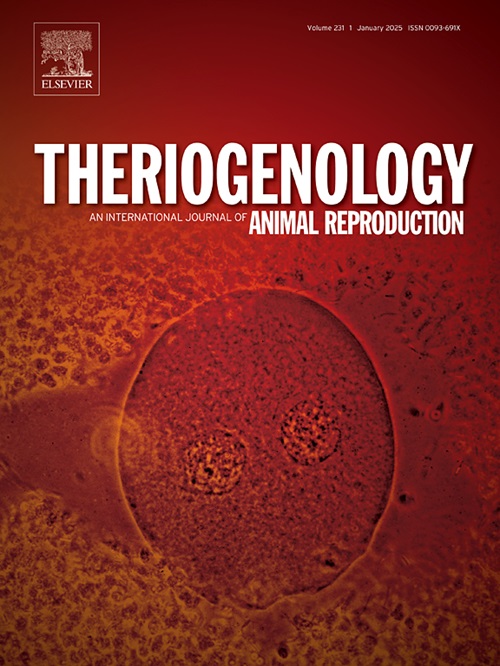冷冻前精子浓度、冷冻扩展剂和附睾冲洗技术对冷冻保存的种马附睾精子解冻后质量的影响
IF 2.4
2区 农林科学
Q3 REPRODUCTIVE BIOLOGY
引用次数: 0
摘要
在常规去势、安乐死或急性死亡后,对种马附睾精子进行冷冻保存已成为一种常见的临床方法。与射精精子相比,附睾精子的独特特征包括需要从附睾尾部取出精子,不暴露于精浆,以及可能恢复大量精子。在本研究中,研究了冲洗技术(延长剂(INRA) vs. AIR)、冷冻延长剂(LE、CMLE、MFR5、CFR5或BOTU)和冷冻精子浓度(200、400或800 × 106精子/mL)对解冻后附睾精子质量的影响。与AIR (10 × 109)相比,INRA (14 × 109)冲洗附睾尾时恢复的精子总数更多。与LE、MFR5和CFR5相比,BOTU和CMLE冷冻保存的附睾精子解冻后总活力和进展活力更高(P <;0.05);BOTU、MFR5和CFR5比CMLE或LE产生更高的解冻后活精子/顶体完整精子(P <;0.05);CMLE、CFR5和BOTU的解冻后曲线速度高于LE或MFR5 (P <;0.05);扩展剂对精子DNA损伤(COMPαt)无明显影响(P >;0.05)。总体而言,不同冷冻保存浓度的附睾精子解冻后质量参数相似(P <;0.05)。本研究为影响种马附睾精子解冻后质量的一些因素提供了证据。本文章由计算机程序翻译,如有差异,请以英文原文为准。
Effect of pre-freeze sperm concentration, freezing extender, and epididymal flushing technique on post-thaw quality of cryopreserved epididymal stallion sperm
Cryopreservation of stallion epididymal sperm has become a common clinical procedure after routine castration, euthanasia, or acute death. Unique features of epididymal sperm compared to ejaculated sperm include the requirement to remove sperm from the cauda epididymis, lack of exposure to seminal plasma, and potential recovery of large sperm numbers. In this study, the effect of the flushing technique (Extender (INRA) vs. AIR), freezing extender (LE, CMLE, MFR5, CFR5, or BOTU), and the concentration at which sperm are cryopreserved (200, 400, or 800 × 106 sperm/mL) on post-thaw epididymal sperm quality were studied. More total sperm were recovered when the cauda epididymides were flushed with INRA (14 × 109) compared to AIR (10 × 109). Epididymal sperm cryopreserved in BOTU and CMLE yielded higher post-thaw total and progressive motility than LE, MFR5, and CFR5 (P < 0.05); BOTU, MFR5, and CFR5 yielded higher post-thaw viable/acrosome-intact sperm than CMLE or LE (P < 0.05); CMLE, CFR5, and BOTU yielded higher post-thaw curvilinear velocity than LE or MFR5 (P < 0.05); an effect of extender on sperm DNA damage (COMPαt) was not observed (P > 0.05). Overall, similar post-thaw epididymal sperm quality parameters were observed among different cryopreserved sperm concentrations (P < 0.05). This study provides evidence of some factors that can affect the post-thaw quality of epididymal sperm from stallions.
求助全文
通过发布文献求助,成功后即可免费获取论文全文。
去求助
来源期刊

Theriogenology
农林科学-生殖生物学
CiteScore
5.50
自引率
14.30%
发文量
387
审稿时长
72 days
期刊介绍:
Theriogenology provides an international forum for researchers, clinicians, and industry professionals in animal reproductive biology. This acclaimed journal publishes articles on a wide range of topics in reproductive and developmental biology, of domestic mammal, avian, and aquatic species as well as wild species which are the object of veterinary care in research or conservation programs.
 求助内容:
求助内容: 应助结果提醒方式:
应助结果提醒方式:


